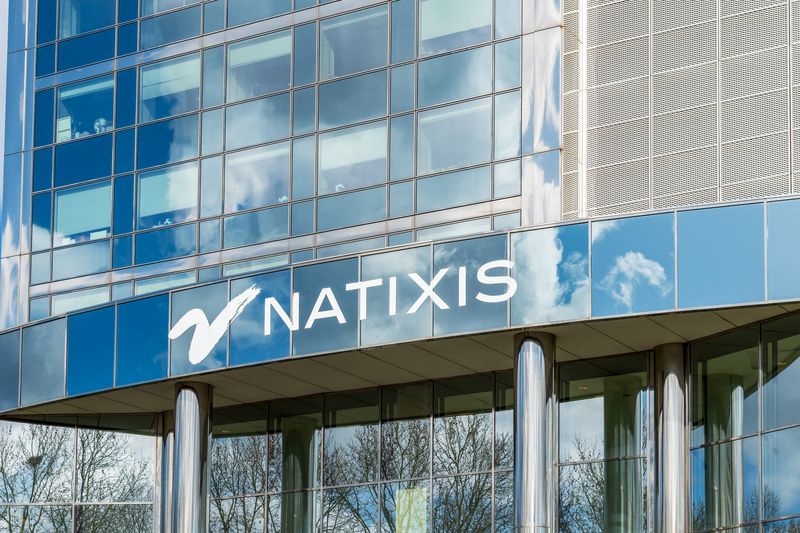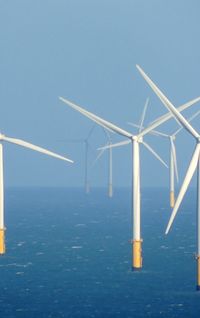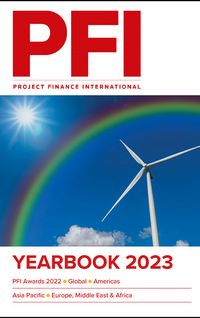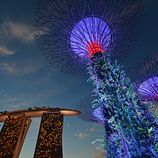Bank of the Year – Natixis
French bank Natixis has had a presence in the Gulf region for many years and has upped its profile over the last decade. Indeed, at one stage just before Covid hit it was on many of the deals in the region. Lately it has been more selective and has worked on arranging deals in much smaller clubs while still keeping an eye on the wider market.
This year Natixis has been involved in leading a unique range of project deals. It has been leading the US$730m, 150,000-cubic-metres-per-day Al Wakrah and Al Wukair sewage treatment plant (STP) project in Qatar, which is expected to close very shortly. It was also one of the original arrangers backing the Metito/Al Attiya Motors & Trading/Gulf Investment Corporation winning team, along with Apicorp and Siemens Bank.
The bank arranged the first data centre deal in the region, a US$68m seven-year non-recourse senior debt bullet facility with a cash sweep mechanism for the inaugural hyperscale data centre at the King Salman Energy Park (SPARK) in Dammam being developed by the Quantum Switch and Tamasuk joint venture. The deal was sold down to Allianz Trade and Riyad Bank.
Natixis arranged the first independent FiberCo structured financing in the region, a US$200m partially amortising facility that incentivises a refinancing as soon as the business ramps up. The deal financed the Saudi acquisition by Technical Link Services (TLS) of fibre-optic assets from Salam, previously Integrated Telecom Company. The US$370m deal will fund the rollout of additional FTTH, FTTB, and FTTS assets, planned to be completely rolled out by 2025.
The bank was involved in other deals, for example the refinancing of the 800MW Shuaa 2 solar scheme in Dubai via a US$690m soft mini-perm deal split and the US$13.4bn loan backing the purchase by a BlackRock/Hassana-led team of a 49% stake in Aramco's gas pipeline network. It is also lead-arranging the project financing for ACWA Power’s 700MW Ar Raas solar scheme in Saudi.
The regional head of Natixis in the Middle East is Barbara Riccardi. Adel Elsolh is the co- head of Middle East investment banking and head of infrastructure and energy finance.
Utility Deal of the Year – TRSDC
The utility style US$1.33bn project financing for The Red Sea Development Company (TRSDC) scheme that closed early in the year set a template model for project finance. The project will serve the leisure mega city property development.
The first phase of the scheme involves an international airport and 16 hotels. The utilities element has a 210MW solar project and a 33,000m3 per day desalination scheme, plus the world’s largest battery storage facility of 1GWh, which is expected to allow the Red Sea project to remain completely off grid and powered by renewables day and night.
The financing structure had to take into account both the fact that the scheme involves a variety of different standalone assets, and will serve as a utility to a property development which is currently being built. The project company will not take volume risk over the 25 years of the concession but will be subject to greater performance risk given the multi-asset nature of the scheme. Areas of operation include transmission and distribution, sewage treatment, district cooling and municipal solid waste management that will add correspondingly to performance risk such as guaranteed levels of MW and cubic metres.
The project is backed by a guarantees from TRSDC’s owner, the Public Investment Fund (PIF). Two more similar mega city utility projects are being procured – Qiddiya and Amaala.
ACWA Power, SPIC Huanghe Hydropower Development Company and Saudi Tabreed District Cooling Company are the project sponsors. The funding banks are Al Rajhi, Saudi British, Saudi Fransi, Riyad, Apicorp and Standard Chartered. In addition, the joint venture has secured equity bridge loan (EBL) facilities from Bank Albilad, Bank Al-Jazira and Arab National Bank. The project financing has three equal sized tranches, a seven-year dollar soft mini-perm, a seven-year riyal soft mini-perm and a 17 year riyad longer-dated tranche.
Covington & Burling advised the sponsors and DLA Piper advised the lenders. EY and Clifford Chance advised TRDSC.
PPP Deal of the Year – Madinah 3
The PPP Deal of the Year is actually three separate independent sewerage treatment plant (ISTP) projects – Madinah 3, Buraydah 2 and Tabuk 2. They were procured in a batch with Madinah 3 being the largest at 200,000m3/day, which can be expanded to 375,000m3/day, and as such it was used as the contractual framework for the financing of the other two.
A further complexity was that during the tender treated sewage effluent (TSE) pipelines were added to the scope of the projects. This added to the debt and equity financing size while keeping competitive bidding tension on the assets. The pipelines will be transferred on completion of construction to the National Water Company (NWC) while the ISTPs will remain with the concessionaire for 25 years once built.
The project is sponsored by a consortium of Spain’s Acciona and local companies Tawza and Tamasuk. The scheme has 100% private-sector ownership of the project company with no government shareholding, but is backed by a Ministry of Finance credit support agreement.
A US$700m soft mini-perm was raised for the three ISTPs via a green loan. The multi-sourced financing included conventional term debt facilities from MUFG, Siemens Bank and Riyad Bank, and an Islamic wakala ijara finance lease provided by Alinma Bank and Abu Dhabi Islamic Bank.
The financial close for each of the three ISTPs was achieved in six months, which has never been done before in the Saudi waste-water sector. The scheme achieved the lowest ISTP tariffs in Saudi Arabia at SR1.2157/m3 (US$0.32) on the Madinah 3 scheme and SR1.4395/m3 on the Buraydah 2 and Tabuk 2 schemes.
Deloitte and Pinsent Masons advised the consortium on the deal, while Eversheds Sutherland advised the lenders. SMBC, DLA Piper and ILF advised the client, Saudi Water Partnership Company (SWPC).
Central Asian Deal of the Year – Zarafshan
Masdar financed the first mega renewables deal in Uzbekistan this year, the 500MW, US$580m Zarafshan wind farm in the Navoi region. The deal follows on from its 100MW Nur Navoi Solar PV project – the first PPP and IPP in Uzbekistan – which was funded in December 2020.
The country continues to be a source of opportunities for international developers, lenders and advisers, as the government accelerates its infrastructure, energy and renewables development programme. The government wants 8GW of renewables in place by 2026 and a further 4GW by 2030 – a total of 12GW, of which 5GW will be wind and 7GW solar.
Masdar managed to arrange a 20-year financing for the Zarafshan project with a twist. The deal is the first project financing involving new Emirates export credit agency (ECA) Etihad Credit Insurance (ECI). Sovereigns in the Gulf have started to establish ECAs, with Saudi being the first. However, this is the first, to our knowledge, international project financing involving a Gulf ECA.
A further innovation was that EBRD provided a revolver to cover construction period VAT payments – the first time a development finance institution (DFI) had offered such a product in the country and no doubt a precedent for future transactions in this market and others.
The 20-year uncovered debt totals US$360m and will be provided by multilaterals the IFC, EBRD, ADB, and JICA. In addition there will be a US$102m tranche backed by ECI with liquidity provided by FAB and Natixis.
Cranmore Partners and Norton Rose Fulbright advised Masdar, with Clifford Chance advising the lenders and White & Case the government.
The project company is called Shamol Zarafshan Energy. The wind farm is expected to begin commercial operation by the end of 2024. The power purchase agreement (PPA) on the scheme runs for 25 years with state-owned National Electric Grid of Uzbekistan (NEGU) the single buyer and offtaker. The scheme will be built by Sepco 3 with Goldwind turbines. It was bilaterally negotiated with NEGU.
Power Deal of the Year – Lightning
The Abu Dhabi Lightning project was unique in many ways, one being that it is the first high voltage direct current (HVDC) subsea transmission project in the Middle East and North Africa. The US$3.8bn scheme will supply ADNOC’s offshore fields with cleaner power from Taqa’s onshore network for 35 years.
In addition, there is no project financing precedent for subsea transmission projects and all the scheme participants had to work on drafting bespoke project and financing documents for the scheme.
The project was won by a Kepco/Kyushu Electric Power/EDF team, which will hold 40% of the scheme with ADNOC and Taqa having 30% each. The deal was backed by US$3.2bn of construction 5.5-year debt with 75% being provided by export credit agencies (ECAs) Kexim and JBIC. On top of that there is US$720m of equity bridge loans (EBLs).
The commercial banks are Mizuho, SMBC, BNP Paribas and Standard Chartered. The equity bridge loan (EBL) banks are BNP Paribas, SMTB and Nonghyup Bank. SMBC advised the consortium while Alderbrook, MUFG and Mott MacDonald advised ADNOC. Legal advisers on the deal were Ashurst, Norton Rose Fulbright, White & Case, Milbank and Al Tamini.
The scheme was not only unique, the financing had to contend with rising interest rates as it moved to financial close in September, leading to an increase in debt sizing. In addition, the use of a hard mini-perm structure is an important new factor for the ECAs. Insurance for subsea cable projects was another key challenge for the scheme. Bids for the project were submitted in late 2020 just when Covid was at its height.
The scheme will comprise two independent 259km subsea HVDC transmission links and converter stations. The scheme will provide 3.2GW of installed capacity. The project has an interesting technical element in that the cable will need to be buried in the seabed and not laid on top of it. Samsung C&T Corp and Belgium’s Jan De Nul are working with the Kepco-led team on design and construction of the project.
Green Deal of the Year – Neom Helios
It is breaking the rules to give a deal of the year award to a transaction that has not reached financial close but once in a blue, sorry green, moon an exception to the rule can be made. The hype surrounding the development of the hydrogen sector as the clean fuel for the future has shown no signs whatsoever of abating this year. Indeed, the hype has grown – with new mega projects and new ground-breaking initiatives emerging every day.
So in order to keep ones feet firmly on the ground, it is salutory to report on the financing of the first major international project in the sector that has made significant strides this year in the global financing markets and is due to sign very shortly – the US$7bn Air Products, ACWA Power and Neom Helios scheme.
The scheme brings together global industrial gases producer Air Products with Saudi-owned and Gulf-based power and renewables developer ACWA Power and the Public Investment Fund-owned smart city development Neom located in the north-west of Saudi Arabia. The financing for this first-of-a-kind project was launched at the start of year and was oversubscribed among banks looking to get into the sector. Air Products will wrap the construction of the project and buy the offtake, and it is a sponsor big enough to provide this kind of support.
The scheme involves the export of liquid ammonia to serve the global city bus and truck market. Air Products believes it will need to supply 20,000 buses, out of a total market of 3m buses around the world, to have a successful project. It says it will sign long-term contracts with cities. City clients, having decided to invest in new hydrogen bus fleets, will want to sign up long-term hydrogen fuel supply contracts, Air Products believes, even if costs of hydrogen production could come down in later years. Hydrogen is seen as the alternative green energy for buses and heavy trucks. Batteries used in electric vehicle (EV) cars would be too heavy for buses and trucks.
The scheme will see ACWA building 4GW of solar and wind capacity. The solar energy will be used during the day and the wind energy in the evening. Storage capacity will be built to ensure a continuous supply of power
The Kingdom’s new National Infrastructure Fund (NIF) is looking at financing the project. The commercial banks tranche is expected to be around US$2bn with Saudi government soft loan institution SIDF upping its US$1bn tranche. German export credit agency Hermes is due to provide US$800m. Between 15 and 20 banks are involved in the deal.
African Power Deal of the Year – SOLA
Cape Town-based independent power producer (IPP) SOLA Group closed the largest project financing in Africa to feature a wheeling corporate power purchase agreement (CPPA). The R3.1bn (US$180m) of debt is backing the construction of two photovoltaic plants, of 100MW each, with a total project cost of R4bn.
The wheeling CPPA is an innovative offtake agreement that allows the offtaker to enter into a direct supply agreement with the IPP without exclusivity commitments on either side. The wheeling deal is an offset transaction where Eskom, as South Africa’s transmission system operator, meters the IPP generation and the offtaker’s usage and offsets the kWhs generated by the IPP against the offtaker’s Eskom invoice.
This was the first major deal to reach financial close under updated rules on contract termination between IPPs and offtakers in South Africa. Under the new regime, IPPs only receive a termination payment equal to a multiple of annual revenues due, between three to five years forecast revenues. This leaves offtakers with a significantly reduced liability to IPPs and is the first step towards accepting that where one offtaker defaults, the IPP would be in a position to find an alternative. Tronox will power between 30% and 40% of its operations at five of its facilities in the Western Cape and KwaZulu-Natal. The projects are now ready to start construction and to start supplying power in 2023.
South African banks Nedbank, Standard Bank, Absa and the Development Bank of Southern Africa (DBSA) were senior lenders. SOLA and African Rainbow Energy and Power (AREP) jointly provided R900m of equity. AREP, a subsidiary of mining company African Rainbow Minerals (ARM), holds 41% in SOLA.
Gauteng-based PepperTree Capital was lead financial adviser to the banks, SOLA and AREP. PepperTree’s team involved James Barker, John Taylor, Zahed Sibda, Jon Adams, Lebo Mahlare and Sija Novodu. New York-listed miner Tronox is the offtaker and has signed a 20-year wheeling CPPA. Allen & Overy’s Johannesburg team advised Tronox, led by partner Alessandra Pardini alongside counsel Alexandra Felekis.
African Deal of the Year – Panther
The Chevron and Nigerian National Petroleum Company (NNPC) joint venture has financed a US$1.4bn loan to help monetise reserves, increase production by arresting the decline in the JV’s assets and support the energy transition via producing gas for domestic supplies. The deal was two times oversubscribed and was backed by 16 international banks. It was split between a US$840m commercial bank loan and a US$560m Chevron co-lending facility.
The gas well development in the project supports Nigeria’s energy transition aspirations through increased use of gas resources for local commercialisation. The project output includes 40% for gas production, all of which will be sent to the local gas supply network. The no-flare facilities reduce the project’s carbon intensity.
The banks in the deal are financial adviser Standard Chartered, Societe Generale, UBA, ICBC, Deutsche Bank, Union Bank of Nigeria, Bank of China, Nedbank, ICBC Standard, First Bank, Zenith Bank, ABSA, RMB, Standard Bank, Access Bank and Guaranty Trust Bank. White & Case is advising the lenders and Latham & Watkins the sponsors.
This is the third deal of its kind by Chevron but is the largest thus far. It signed its previous deal in November 2017, backed by US$400m from Nigerian commercial banks and US$380m from international banks including SMBC, Nedbank, RMB, Absa, Citigroup, Standard Chartered and Bank of China. Chevron provided a co-loan on the deal. In 2015 its signed a US$1.2bn financing.
The financing has been structured using a fully amortising structure with a longer availability period and an over-lapping typical repayment period, whereby the sponsors can benefit from reduced financing costs. The seven-year loan is said to be priced at around 500bp.
The fields involved in the financing are offshore and include OML 49, 50 and 95. NNPC’s chief financial officer Umar Ajiya said the deal would yield the Nigerian state US$6bn over 20 years. The financing follows the enactment of a new framework in the country under the Petroleum Industry Act (PIA).
To see the digital version of this report, please click here
To purchase printed copies or a PDF of this report, please email leonie.welss@lseg.com
















